lock PORSCHE CAYNNE 2008 1.G Information Manual
[x] Cancel search | Manufacturer: PORSCHE, Model Year: 2008, Model line: CAYENNE, Model: PORSCHE CAYENNE 2008 1.GPages: 95, PDF Size: 3.37 MB
Page 10 of 95
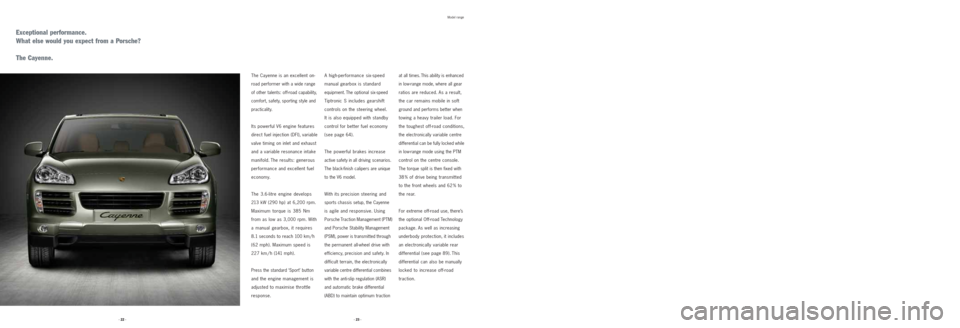
Model range
Exceptional performance.
What else would you expect from a Porsche?
The Cayenne.
A high-performance six-speed
manual gearbox is standard
equipment. The optional six-speed
Tiptronic S includes gearshift
controls on the steering wheel.
It is also equipped with standby
control for better fuel economy
(see page 64).
The powerful brakes increase
active safety in all driving scenarios.
The black-finish calipers are unique
to the V6 model.
With its precision steering and
sports chassis setup, the Cayenne
is agile and responsive. Using
Porsche Traction Management (PTM)
and Porsche Stability Management
(PSM), power is transmitted through
the permanent all-wheel drive with
efficiency, precision and safety. In
difficult terrain, the electronically
variable centre differential combines
with the anti-slip regulation (ASR)
and automatic brake differential
(ABD) to maintain optimum traction
at all times. This ability is enhanced
in low-range mode, where all gear
ratios are reduced. As a result,
the car remains mobile in soft
ground and performs better when
towing a heavy trailer load. For
the toughest off-road conditions,
the electronically variable centre
differential can be fully locked while
in low-range mode using the PTM
control on the centre console.
The torque split is then fixed with
38 % of drive being transmitted
to the front wheels and 62 % to
the rear.
For extreme off-road use, there’s
the optional Off-road Technology
package. As well as increasing
underbody protection, it includes
an electronically variable rear
differential (see page 89). This
differential can also be manually
locked to increase off-road
traction.
The Cayenne is an excellent on-
road performer with a wide range
of other talents: off-road capability,
comfort, safety, sporting style and
practicality.
Its powerful V6 engine features
direct fuel injection (DFI), variable
valve timing on inlet and exhaust
and a variable resonance intake
manifold. The results: generous
performance and excellent fuel
economy.
The 3.6-litre engine develops
213 kW (290 hp) at 6,200 rpm.
Maximum torque is 385 Nm
from as low as 3,000 rpm. With
a manual gearbox, it requires
8.1 seconds to reach 100 km / h
(62 mph). Maximum speed is
227 km / h (141 mph).
Press the standard ‘Sport’ button
and the engine management is
adjusted to maximise throttle
response.
· 23 · · 22 ·
Page 23 of 95
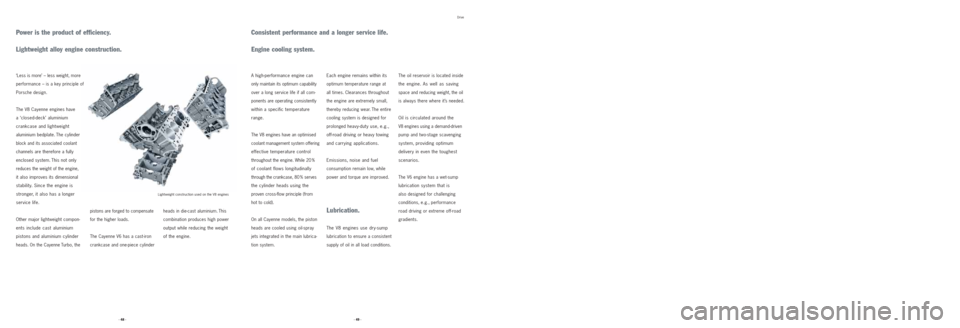
Power is the product of efficiency.
Lightweight alloy engine construction.
‘Less is more’ – less weight, more
performance – is a key principle of
Porsche design.
The V8 Cayenne engines have
a ‘closed-deck’ aluminium
crankcase and lightweight
aluminium bedplate. The cylinder
block and its associated coolant
channels are therefore a fully
enclosed system. This not only
reduces the weight of the engine,
it also improves its dimensional
stability. Since the engine is
stronger, it also has a longer
service life.
Other major lightweight compon-
ents include cast aluminium
pistons and aluminium cylinder
heads. On the Cayenne Turbo, the
pistons are forged to compensate
for the higher loads.
The Cayenne V6 has a cast-iron
crankcase and one-piece cylinderheads in die-cast aluminium. This
combination produces high power
output while reducing the weight
of the engine.
Drive
Lightweight construction used on the V8 engines
Consistent performance and a longer service life.
Engine cooling system.
Each engine remains within its
optimum temperature range at
all times. Clearances throughout
the engine are extremely small,
thereby reducing wear. The entire
cooling system is designed for
prolonged
heavy-duty use, e.g.,
off-road driving or heavy towing
and carrying applications.
Emissions, noise and fuel
consumption remain low, while
power and torque are improved.
Lubrication.
The V8 engines use dry-sump
lubrication to ensure a consistent
supply of oil in all load conditions.
The oil reservoir is located inside
the engine. As well as saving
space and reducing weight, the oil
is always there where it’s needed.
Oil is circulated around the
V8 engines using a demand-driven
pump and two-stage scavenging
system, providing optimum
delivery in even the toughest
scenarios.
The V6 engine has a wet-sump
lubrication system that is
also designed for challenging
conditions, e.g., performance
road driving or extreme off-road
gradients.
A high-performance engine can
only maintain its optimum capability
over a long service life if all com-
ponents are operating consistently
within a specific temperature
range.
The V8 engines have an optimised
coolant management system offering
effective temperature control
throughout the engine. While 20 %
of coolant flows longitudinally
through the crankcase, 80 % serves
the cylinder heads using the
proven cross-flow principle (from
hot to cold).
On all Cayenne models, the piston
heads are cooled using oil-spray
jets integrated in the main lubrica-
tion system.
· 49 · · 48 ·
Page 31 of 95
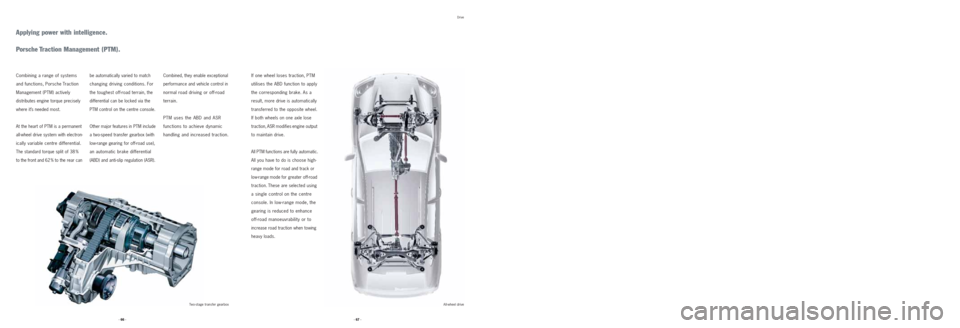
Drive
Applying power with intelligence.
Porsche Traction Management (PTM).
If one wheel loses traction, PTM
utilises the ABD function to apply
the corresponding brake. As a
result, more drive is automatically
transferred to the opposite wheel.
If both wheels on one axle lose
traction, ASR modifies engine output
to maintain drive.
All PTM functions are fully automatic.
All you have to do is choose high-
range mode for road and track or
low-range mode for greater off-road
traction. These are selected using
a single control on the centre
console. In low-range mode, the
gearing is reduced to enhance
off-road manoeuvrability or to
increase road traction when towing
heavy loads.
be automatically varied to match
changing driving conditions. For
the toughest off-road terrain, the
differential can be locked via the
PTM control on the centre console.
Other major features in PTM include
a two-speed transfer gearbox (with
low-range gearing for off-road use),
an automatic brake differential
(ABD) and anti-slip regulation (ASR).
Combining a range of systems
and functions, Porsche Traction
Management (PTM) actively
distributes engine torque precisely
where it’s needed most.
At the heart of PTM is a permanent
all-wheel drive system with electron-
ically variable centre differential.
The standard torque split of 38 %
to the front and 62 % to the rear canCombined, they enable exceptional
performance and vehicle control in
normal road driving or off-road
terrain.
PTM uses the ABD and ASR
functions to achieve dynamic
handling and increased traction.
All-wheel drive Two-stage transfer gearbox
· 67 · · 66 ·
Page 33 of 95

Cayenne Turbo
1. Compressed air cylinder
2. Air suspension and PASM
control unit
3. Air suspension struts
4. Air suspension compressor5. Catalytic converter
6. Silencers
7. Gear selector unit
(Tiptronic S)
8. Tiptronic S transmission9. Two-stage transfer
gearbox with lockable
centre differential
10. Double wishbone
suspension
11. Multi-link suspension
10
11
1
1
2
3
3
34
5
7
89
6
· 71 · · 70 ·
Chassis
Page 35 of 95

Chassis
Exceptional power requires accurate direction.
Steering.Tough for off road, light for the track, stylish for any terrain.
Wheels.
The electrically adjustable steer-
ing column has a driver-selectable
‘Easy Entry’ function, which raises
the steering wheel towards the
dashboard whenever you enter
or leave the car. The comfort and
sports seat options (standard on
Cayenne GTS and Cayenne Turbo)
have a comfort memory package
that stores your preferred
wheel position as well as seat
and exterior mirror settings.
The steering column consists of
multiple collapsing sections linked
by three universal joints. A special
deformation element offering
70 mm of travel provides a high
level of safety in the event of front
impact.
Servotronic.
Servotronic is a speed-sensitive
power steering system available
as an option on all Cayenne
models.
At higher speeds, the steering
becomes firmer, inputs are more
precise and driver comfort is
greatly enhanced.
At lower speeds, it enables easy
manoeuvrability and parking. For optimum manoeuvrability, on
and off road, all Cayenne models
have variable-ratio steering
and special valve settings on
the power-steering system. Lock-
to-lock travel is a modest
2.65 turns, while the turning
circle is just 11.7 metres.
The steering wheel can be adjusted
by 50 mm for reach and 40 mm
for height. Both adjustment options
are electrically assisted on
the Cayenne GTS and Cayenne
Turbo. Electric adjustment is also
available as an option on the
Cayenne and Cayenne S as part
of the optional comfort or sports
seat package (each with comfort
memory package). The optional
padded steering wheel (standard
on Cayenne GTS) brings added
sporting style to each model.
the multi-purpose display in the
instrument cluster. Standard wheel fitments are as
follows: 17-inch Cayenne alloys on
the Cayenne, 18-inch Cayenne S II
on the Cayenne S, 21-inch
Cayenne Sport on the Cayenne
GTS and 19-inch Cayenne Design
on the Cayenne Turbo.
For a more personal touch, you
can choose from a range of
wheel options (see page 160).
Tyre Pressure Monitoring
(TPM).
The optional TPM warns of any
drop in pressure via the on-board
computer display. In addition,
the driver can check the individual
pressures in all four wheels via
17-inch Cayenne wheel 18-inch Cayenne S II wheel
21-inch Cayenne Sport wheel 19-inch Cayenne Design wheel
· 75 · · 74 ·
Page 40 of 95
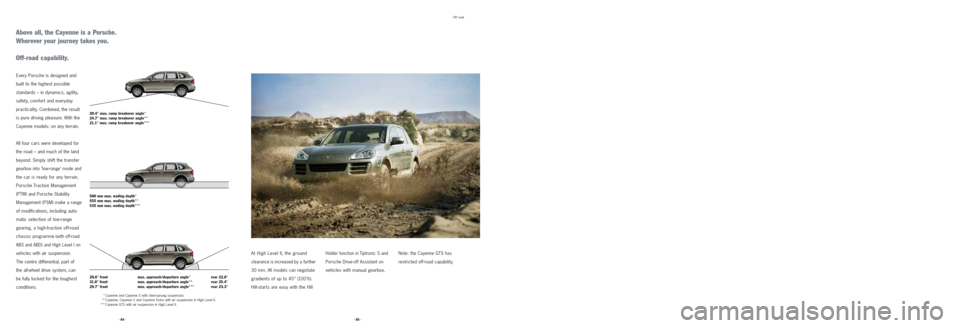
Off road
Every Porsche is designed and
built to the highest possible
standards – in dynamics, agility,
safety, comfort and everyday
practicality. Combined, the result
is pure driving pleasure. With the
Cayenne models: on any terrain.
All four cars were developed for
the road – and much of the land
beyond. Simply shift the transfer
gearbox into ‘low-range’ mode and
the car is ready for any terrain.
Porsche Traction Management
(PTM) and Porsche Stability
Management (PSM) make a range
of modifications, including auto-
matic
selection of low-range
gearing, a high-traction off-road
chassis
programme (with off-road
ABS and
ABD) and High Level I on
vehicles
with air suspension.
The centre differential, part of
the all-wheel drive system, can
be fully locked for the toughest
conditions.At High Level II, the ground
clearance is increased by a further
30 mm. All models can negotiate
gradients of up to 45° (100 %).
Hill-starts are easy with the Hill
Holder function in Tiptronic S and
Porsche Drive-off Assistant on
vehicles with manual gearbox.
28.6° front max. approach /departure angle * rear 22.8°
31.8° front max. approach /departure angle * * rear 25.4°
29.7° front max. approach /departure angle * * * rear 23.3°
20.4° max. ramp breakover angle *
24.7° max. ramp breakover angle * *
21.1° max. ramp breakover angle***
500 mm max. wading depth *
555 mm max. wading depth * *
535 mm max. wading depth * * *
*** Cayenne and Cayenne S with steel-sprung suspension.
*** Cayenne, Cayenne S and Cayenne Turbo with air suspension in High Level II.
*** Cayenne GTS with air suspension in High Level II.
Note: the Cayenne GTS has
restricted off-road capability.
· 85 · · 84 ·
Above all, the Cayenne is a Porsche.
Wherever your journey takes you.
Off-road capability.
Page 42 of 95

Off road
Applying power with sensitivity, protecting with strength.
Off-road Technology package.
The rear differential enables
optimum distribution of engine
torque in difficult off-road terrain.
A fully automated part of the
all-wheel system, its primary
function is to optimise traction.
If one of the rear wheels begins
to lose grip, the differential varies
the torque transmitted through
each drive shaft, thereby restoring
traction. Available as a factory-fitted
option on all Cayenne models, the
Off-road Technology package*
incorporates an electronically
variable and lockable rear
differential as part of the standard
all-wheel drive system. Other
features include high-strength
rock-rails with integrated skid
plates, a reinforced engine-bay
guard, enhanced protection for
the fuel tank and rear axle, and
a second towing lug.In low-range mode, the rear
differential can be manually
locked using the main off-road
control on the centre console.
In this state, both rear wheels
receive the same amount of
torque.
For additional off-road protection,
optional wheel-arch extensions
(black finish) and running boards*
with integrated skid plates are
available.
* Not available for the Cayenne GTS.
· 89 · · 88 ·
Page 44 of 95
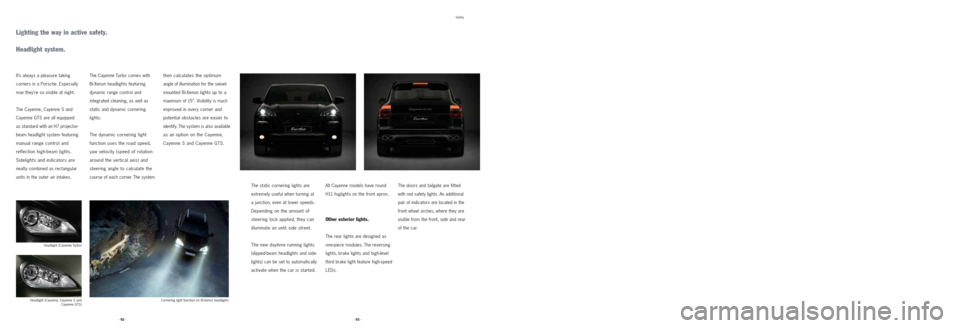
The Cayenne Turbo comes with
Bi-Xenon headlights featuring
dynamic range control and
integrated cleaning, as well as
static and dynamic cornering
lights.
The dynamic cornering light
function uses the road speed,
yaw velocity (speed of rotation
around the vertical axis) and
steering angle to calculate the
course of each corner. The system
Lighting the way in active safety.
Headlight system.
Safety
The static cornering lights are
extremely useful when turning at
a junction, even at lower speeds.
Depending on the amount of
steering lock applied, they can
illuminate an unlit side street.
The new daytime running lights
(dipped-beam headlights and side-
lights) can be set to automatically
activate when the car is started.
Headlight (Cayenne, Cayenne S and
Cayenne GTS)
All Cayenne models have round
H11 foglights on the front apron.
Other exterior lights.
The rear lights are designed as
one-piece modules. The reversing
lights, brake lights and high-level
third brake light feature high-speed
LEDs.The doors and tailgate are fitted
with red safety lights. An additional
pair of indicators are located in the
front wheel arches, where they are
visible from the front, side and rear
of the car.
Cornering light function on Bi-Xenon headlights
then calculates the optimum
angle of illumination for the swivel-
mounted Bi-Xenon lights up to a
maximum of 15°. Visibility is much
improved in every corner and
potential obstacles are easier to
identify. The system is also available
as an option on the Cayenne,
Cayenne S and Cayenne GTS.
Headlight (Cayenne Turbo)
It’s always a pleasure taking
corners in a Porsche. Especially
now they’re so visible at night.
The Cayenne, Cayenne S and
Cayenne GTS are all equipped
as standard with an H7 projector-
beam headlight system featuring
manual range control and
reflection high-beam lights.
Sidelights and indicators are
neatly combined as rectangular
units in the outer air intakes.
· 93 · · 92 ·
Page 47 of 95

Oversteer with PSM
Understeer without PSM
Car steers
off line Car steers
off line PSM corrects
line and
stabilises car
PSM corrects
line and
stabilises car
Understeer with PSM Oversteer without PSM
All Cayenne models are
equipped with Porsche Stability
Management (PSM) as standard.
This electronic control system
uses a range of functions –
including anti-lock braking (ABS) –
to help stabilise the vehicle
(and trailer, if fitted) in hazardous
road scenarios. Throughout each
journey, PSM uses a range of
sensors to monitor the direction,
speed, yaw velocity (speed of
rotation around the vertical axis)
and lateral acceleration of the
car. The system then calculates
the actual direction of travel. If
the car begins to oversteer or
understeer, PSM applies selective
braking on individual wheels to
restore stability. If necessary,
PSM can also intervene in the
engine management system to
temporarily modify the amount
of drive to the wheels.PSM has two additional functions
that help reduce braking distances.
If the throttle pedal is released
suddenly, PSM automatically
readies the braking system. The
pressure in the brake lines is
marginally increased, bringing
each of the pads into light contact
with the corresponding disc. If the
driver goes on to apply the brakes,
the calipers respond more quickly.
In an emergency stop – i.e., when
the pressure on the brake pedal
exceeds a certain threshold –
the brake assist function uses
the PSM hydraulics to apply
maximum braking force at all
four wheels.
PSM makes a significant contribu-
tion to car and trailer safety –
within the laws of physics. It
compensates for load transfer
caused by throttle and brake
inputs up to the maximum degree
of lateral acceleration. It also
enhances the car’s driving dynam-
ics and directional stability when
accelerating on variable road
surfaces. PSM can also intervene
through the locking centre and
axle differentials as part of
Porsche Traction Management
(PTM).
Other features include a
special control strategy in
the PSM-integrated ABS for braking on loose surfaces such
as gravel or snow. By briefly
locking the wheels, a wedge is
formed ahead of each tyre which
provides additional purchase
to help slow the car.
For a more active driving experi-
ence, PSM can also be disabled.
For safety reasons, it remains
active in the background, ready
to intervene in critical scenarios.
Expecting the best means preparing for the worst.
Porsche Stability Management (PSM).
Safety
· 99 · · 98 ·
Page 61 of 95

Comfort, ergonomics and security.
Anti-theft protection.
The Cayenne models are all
equipped as standard with an
engine immobiliser and anti-theft
alarm featuring ultrasonic interior
surveillance.
The alarm circuit includes all four
doors, engine lid, tailgate, rear
screen, interior, ignition and trailer
(if fitted).
The immobiliser system works by
automatically communicating with
the vehicle key. If the key is ap-
proved, the engine can be started
as normal.
When the key is removed from the
ignition, the steering column is
automatically locked to provide
additional security.
Porsche Entry & Drive.
With this optional system, you can
reduce the inconvenience of a con-
ventional key.
The moment you touch the door
handle
, the system automatically
checks the encrypted access code
on the key in your pocket. If the
code is accepted, the doors are
unlocked. To start or stop the
engine, simply push the ignition
button.
To lock the car on leaving, all you
have to do is press a button on the
outside of the door handle. Porsche
Entry & Drive then secures the car
doors, arms the immobiliser and
locks the steering column.
Preparation for vehicle
tracking system.
This optional preparation available
for all Cayenne models enables
future installation of a vehicle
tracking system obtainable from
Porsche Tequipment. The system
can be used to locate a stolen
vehicle across much of Europe.
Includes special wiring loom,
higher capacity battery (depend-
ing on vehicle specification) and
tilt sensor for the alarm system.
Cruise control.
Standard on the Cayenne Turbo
and optional on all other models,
cruise control offers increased
comfort on long-distance journeys.
It can be used at speeds between
30 and 240 km / h (19 and 149 mph)
and is activated using a button on
one of the control stalks.
Slide /tilt sunroof.
Available as an option on all
Cayenne models, the slide/tilt
sunroof is made from tinted
single-pane safety glass and has
a manually adjustable sunscreen.
The roof position is easily adjusted
using a single illuminated rotary
control. The sunroof also has
an anti-jam facility, as do all the
electric windows.
Comfort lighting package.
One of the special features in this
optional package is the ‘Welcome
Home’ lighting function. When you
arrive at a destination after dark,
the headlights remain
illuminated
Comfort
for a user-defined period, lighting
your path from the car. Other
features include courtesy lights
on both exterior
mirrors, auto-
matic headlight activation and
automatically dimming interior
and exterior mirrors.
· 127 · · 126 ·